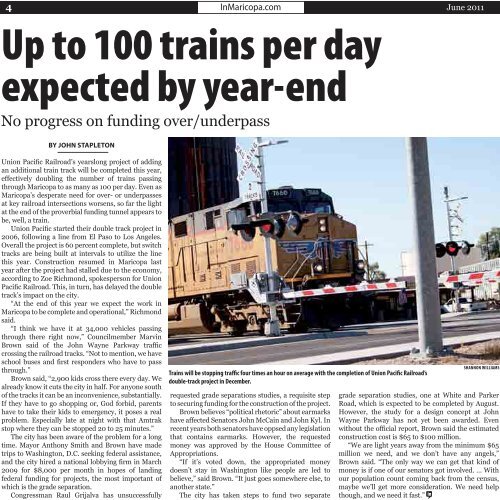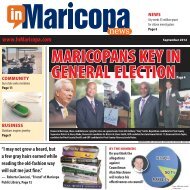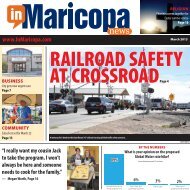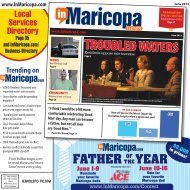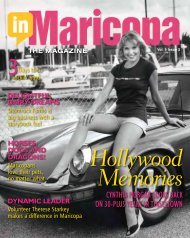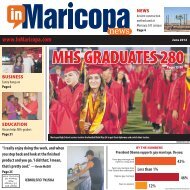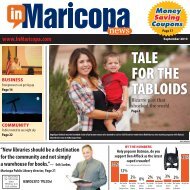June 2011 - InMaricopa.com
June 2011 - InMaricopa.com
June 2011 - InMaricopa.com
Create successful ePaper yourself
Turn your PDF publications into a flip-book with our unique Google optimized e-Paper software.
4 <strong>InMaricopa</strong>.<strong>com</strong> <strong>June</strong> <strong>2011</strong>Up to 100 trains per dayexpected by year-endNo progress on funding over/underpassBy John StapletonUnion Pacific Railroad’s yearslong project of addingan additional train track will be <strong>com</strong>pleted this year,effectively doubling the number of trains passingthrough Maricopa to as many as 100 per day. Even asMaricopa’s desperate need for over- or underpassesat key railroad intersections worsens, so far the lightat the end of the proverbial funding tunnel appears tobe, well, a train.Union Pacific started their double track project in2006, following a line from El Paso to Los Angeles.Overall the project is 60 percent <strong>com</strong>plete, but switchtracks are being built at intervals to utilize the linethis year. Construction resumed in Maricopa lastyear after the project had stalled due to the economy,according to Zoe Richmond, spokesperson for UnionPacific Railroad. This, in turn, has delayed the doubletrack’s impact on the city.“At the end of this year we expect the work inMaricopa to be <strong>com</strong>plete and operational,” Richmondsaid.“I think we have it at 34,000 vehicles passingthrough there right now,” Councilmember MarvinBrown said of the John Wayne Parkway trafficcrossing the railroad tracks. “Not to mention, we haveschool buses and first responders who have to passthrough.”Brown said, “2,900 kids cross there every day. Wealready know it cuts the city in half. For anyone southof the tracks it can be an inconvenience, substantially.If they have to go shopping or, God forbid, parentshave to take their kids to emergency, it poses a realproblem. Especially late at night with that Amtrakstop where they can be stopped 20 to 25 minutes.”The city has been aware of the problem for a longtime. Mayor Anthony Smith and Brown have madetrips to Washington, D.C. seeking federal assistance,and the city hired a national lobbying firm in March2009 for $8,000 per month in hopes of landingfederal funding for projects, the most important ofwhich is the grade separation.Congressman Raul Grijalva has unsuccessfullyTrains will be stopping traffic four times an hour on average with the <strong>com</strong>pletion of Union Pacific Railroad’sdouble-track project in December.requested grade separations studies, a requisite stepto securing funding for the construction of the project.Brown believes “political rhetoric” about earmarkshave affected Senators John McCain and John Kyl. Inrecent years both senators have oppsed any legislationthat contains earmarks. However, the requestedmoney was approved by the House Committee ofAppropriations.“If it’s voted down, the appropriated moneydoesn’t stay in Washington like people are led tobelieve,” said Brown. “It just goes somewhere else, toanother state.”The city has taken steps to fund two separateshannon williamsgrade separation studies, one at White and ParkerRoad, which is expected to be <strong>com</strong>pleted by August.However, the study for a design concept at JohnWayne Parkway has not yet been awarded. Evenwithout the official report, Brown said the estimatedconstruction cost is $65 to $100 million.“We are light years away from the minimum $65million we need, and we don’t have any angels,”Brown said. “The only way we can get that kind ofmoney is if one of our senators got involved. … Withour population count <strong>com</strong>ing back from the census,maybe we’ll get more consideration. We need helpthough, and we need it fast.”


